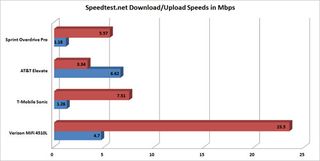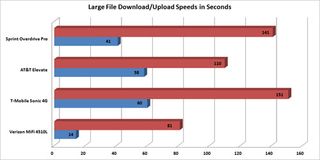Laptop Mag Verdict
The Sierra Wireless Overdrive Pro hotspot offers decent data speeds for a reasonable price, but it's slower than the 4G competition.
Pros
- +
Large, easy-to-read screen
- +
Easily accessible microSD card slot
- +
Competitive website load times
Cons
- -
Slower download speeds than competing hotspots
- -
Device gets very warm during use
- -
Makes irritating beeps
Why you can trust Laptop Mag
Sprint was the first carrier to launch 4G, and the first to launch a 4G mobile hotspot in the Sprint Overdrive. The Sierra Wireless Overdrive Pro 3G/4G hotspot ($49) offers several improvements over its predecessor, including a more compact design, 35 percent faster power-up and shut-down times, and a larger LCD. Now that Sprint has nixed its unlimited 4G data plans for hotspots, is this sequel a good deal?
Design
Unlike other 4G hotspots, Sierra Wireless believes it's hip to be square. The Overdrive Pro measures 2.7 x 2.7 x 0.7 inches with tapered corners and is slightly thicker than its competitors. The LCD is centered on the glossy black front, and the device is coated with soft-touch rubber on the back and edges. A power button sits at the bottom center of the front, with a microUSB port and two external antenna ports on the front edge. The top edge of the device houses the microSD card slot and mute button for turning off Overdrive Pro's various notification chimes.
The LCD has indicators for battery, signal, network speed, number of connected devices, time the device has been on, data consumed during a given session and, finally, the name of the device and password. We prefer the display on the Elevate 4G for AT&T because it includes a counter that keeps track of your overall monthly data usage against your plan's limit.
4G Coverage
Sprint's 4G Mobile WiMax currently covers 71 markets, which pales in comparison to Verizon's 4G LTE network (more than 175 markets) and T-Mobile's HSPA+ 42 network (more than 150 markets). AT&T is far behind these carriers, with only 15 4G LTE markets planned by the end of 2011.
Sprint promises download speeds between 3 and 6 Mbps with bursts up to 10 Mbps.
Shared Storage
The microSD slot holds up to a 32GB microSD card, which can be used for sharing and transferring files among devices connected to the Overdrive Pro. To configure file sharing, go to the device's admin page at http://192.168.0.1 while you're connected to the Overdrive Pro. Up to eight devices can connect to the Overdrive Pro at once.
Performance
After you turn on the Overdrive Pro, it makes a noise to let you know it's connected to 4G. Then it makes another noise when you rouse it out of standby mode. And another when a device connects to it. Or disconnects. For a little hotspot, it's quite chatty. Thankfully, there's a mute button on the top edge of the device.
During our testing in three Chicago locations (Lincoln Park, Mayfair, and the near-west suburb Oak Park), the Overdrive Pro delivered decent speeds, but it trailed competing hotspots. On the download tests on Speedtest.net, the Overdrive Pro clocked an average of 5.6 Mbps. That's within Sprint's advertised range of 3 to 6 Mbps, but the slowest of the four hotspots we tested. It was a full 1 Mbps slower than the AT&T Elevate, the next closest competitor. The Verizon MiFi 4510L took the prize in this race, averaging 23.5 Mbps.
The Overdrive's upload average was 1.18 Mbps, a hair slower than the T-Mobile Sonic 4G's average speed of 1.26 Mbps. But both hotspots choked on the digital dust of the Verizon MiFi 4510L and the Elevate 4G, which averaged 4.7 Mbps and 3.34 Mbps, respectively.

Click to enlarge
Downloading and Uploading Large Files
Downloading a 151MB file took the Overdrive Pro an average of 141 seconds, 30 seconds slower than the Elevate and a full minute longer than the MiFi 4510L, which clocked in at swift 81 seconds. Uploading a 6.5MB file was a much more pleasant experience. The Overdrive Pro did it in an average of 41 seconds, 17 seconds faster than the Elevate and 19 seconds faster than the Sonic 4G. Meanwhile, the MiFi 4510L completed the upload in an average of 14 seconds, 27 seconds faster than the Overdrive Pro.

Click to enlarge
Web Surfing Speed
If you plan on spending most of your time with the Overdrive Pro loading websites, you'll have a decent experience. We averaged the time it took to load Laptopmag.com, CNN.com, ESPN.com, and NYTimes.com in Chrome on a Dell Inspiron 15 (M5030). The Overdrive Pro loaded them in an average of 7.9 seconds, fractions of a second longer than the Elevate and about a second longer than the MiFi 4510L.
Compared to other hotspots, the Overdrive generated a significant amount of heat. When the device was connected to our laptop and we were surfing the Internet, the device became very warm.

Click to enlarge
Battery
The Overdrive Pro is rated for 4 hours of use and 36 hours of standby. The hotspot enters standby mode after just a few minutes of idling, though you can tweak the timeout on the device's admin page. Pressing the power button brings it out of standby mode, but it takes several seconds and a confirmation chime to reconnect to the network. Over several days of intermittent use, the Overdrive Pro needed to be charged once.
Value
The Overdrive Pro is available through Sprint for $49.99 with a two-year contract. As of this writing, Sprint's mobile broadband devices come with 3GB of 3G data and 4G data for $44.99 a month. You can get 5GB for $59.99 a month and 10GB for $89.99 a month.
Verdict
The Overdrive Pro is a decent 4G hotspot, especially if you'll primarily use it to surf the web. However, now that Sprint has nixed its unlimited 4G data plans for devices like this, it's not the best deal. We would rather spend $5 more per month to get Verizon's faster 4G LTE speeds.
Sierra Wireless Overdrive Pro 3G/4G Hotspot Specs
| Company Website | http://www.sprint.com |
| Data Connection | 4G, WiMax, EV-DO Rev. A, CDMA |
| Ports | microUSB, External antenna |
| Size | 2.7 x 2.7 x 0.7 inches |
| Supported Protocols | 802.11b/g/n, 4G, 3G |
| VPN Support | Yes |
| Weight | 3.4 ounces |
